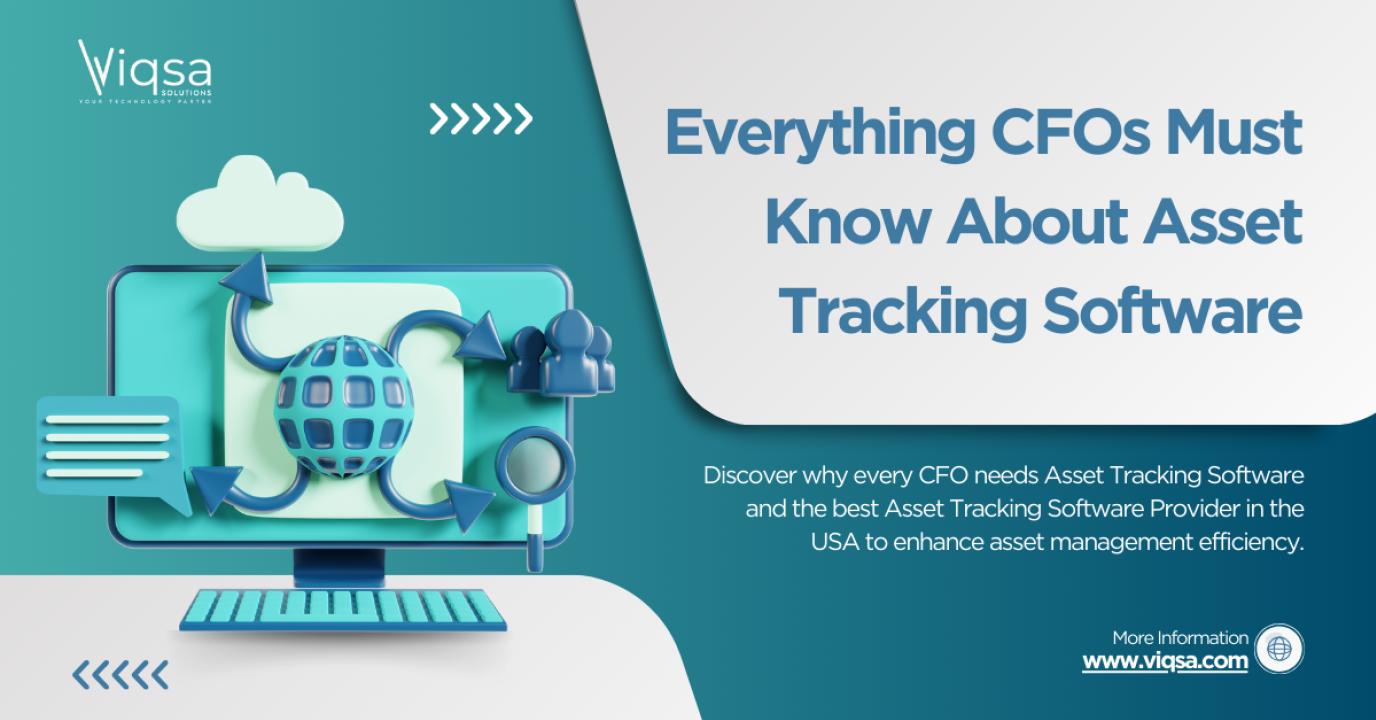What Every CFO Should Know About Asset Tracking Software
The management of your assets is a difficult job for many companies particularly those that manage many assets spread across multiple areas. CFOs are usually charged with making sure that these assets are properly monitored, supervised, and utilized to guarantee profitability. The solution is an asset tracking software that will revolutionize the way companies manage their assets.
This article will explain everything a CFO should be aware of regarding the software for tracking assets, the advantages it offers, and the reasons working with the best asset tracking software provider in USA is vital to the success of your business.
Introduction to Asset Tracking Software
A CFO's job is ensuring your financial wellbeing of a business isn't just about numbers. It's about tracking physical assets. Consider asset tracking software as a navigation system for the company's most valuable assets. Equipment, machinery or even employees software for asset tracking can track the location of every asset, its usage and status in real-time. What is this going to translate to CFOs in particular?
In the simplest terms the end, asset tracking software will improve efficiency, reduce expenses, and boost efficiency, ultimately increasing the bottom line of any company.
Why CFOs Should Care About Asset Tracking
Why would a CFO, person who handles budgets and numbers, be concerned about where assets of a company are located, or the way they are employed? The answer is straightforward each asset is an investment. Assets that are not properly managed or tracked could result in loss. Effectively tracking assets will ensure that they are used correctly and lead to improved financial health.
Imagine a piece of equipment that is sitting in one place that could be put to use elsewhere. Asset tracking software provides CFOs an eye-to-eye view of all assets, making sure they don't let them go unnoticed or ignored.
Key Features of Asset Tracking Software
When searching for software to track assets CFOs should concentrate on the following key attributes:
Real-Time Tracking: Understand where your assets stand at any time.
Automated alerts: You will receive notification regarding repairs, maintenance or any unexpected movement.
Asset Lifecycle Management: Track the entire lifecycle of an asset, from acquisition to disposal.
Analytics and Reporting: Gain insight into the performance of your asset aiding in making decisions.
These tools allow CFOs to have a higher quality of supervision without being distracted by day-today management.
Benefits of Asset Tracking Software for Businesses
The advantages of using an asset tracking software extend far beyond simply knowing where assets are
Reduced downtime: Equipment and machinery are able to be maintained promptly prior to they break down.
Improved productivity: assets are utilized efficiently, reducing waste.
Cost savings: Avoid unnecessary expenditures by maximizing the utilization of resources currently available.
Better accountability Employees are held accountable for the maintenance and use of assets.
For CFOs this means substantial cost savings and improved allocation of resources, which directly contributes to financial achievement.
How Asset Tracking Software Reduces Costs
Every CFO is on search for ways to cut expenses without losing quality and efficiency. Asset tracking software is exactly what it says. By monitoring assets in real-time, companies can cut down on purchase that isn't needed, cut down on repair costs and increase longevity of assets.
Consider the scenario in which an equipment needs to be maintained. Without tracking, a company may only be aware of that the machine fails which can lead to costly maintenance and time-consuming downtime. Asset tracking software can eliminate this by delivering notifications for maintenance routines which saves time and money.
Choosing the Right Asset Tracking Software Provider in the USA
Selecting the best Asset Tracking Software provider in the USA could mean the key to an effective implementation and a waste of investment. Some of the factors to be considered include:
Customization: Can the software provider modify the software to meet your needs?
Support and Training: Does the service provider provide ongoing support and training to your staff?
Scalability: Will the software expand to meet the needs of your company as your assets grow?
By choosing a reliable vendor, you can be sure that your asset tracking system will meet your business's requirements as well as your financial objectives.
Integration of Asset Tracking Software to Existing Systems
One of the most pressing issues that CFOs might face is whether or not new software will seamlessly integrate with the existing systems. The good news is that new asset tracking systems is able to be integrated with ERP, accounting or inventory software. This enables an efficient sharing of information across different platforms which reduces redundancy and errors made through manual processes.
For instance, tracking information can be connected to financial systems that provide real-time information on tax depreciation and asset calculations, giving CFOs a complete view of financial and physical asset management.
Ensuring Data Security in Asset Tracking Software
In the digital age of today security of data is an important priority for any business particularly when it comes to sensitive information about assets. Asset tracking software stores vast amounts of information regarding the assets of your business which makes it a major attack target.
The majority of asset tracking software solutions provide the option of encryption as well as multi-factor authentication and frequent software updates to reduce the risk. CFOs need to ensure that their software vendor takes security of data seriously, protecting the important asset data of the company.
How Asset Tracking Software Improves Regulatory Compliance
Being in compliance with the regulations regardless of whether they're related to audits, taxes as well as industry standard, can be an issue. Asset tracking software eases this by providing comprehensive reports and logs of asset use, locations and other conditions. All with a click of one button.
This simplifies auditing processes but it also ensures that the business remains in compliance with the asset-related regulations and reduces the chance of hefty penalties or fines.
Real-Time Insights for Better Decision Making
The in-real-time information provided by software for tracking assets give CFOs the ability to make well-informed and based decisions. If it's about deciding on assets purchase, maintenance schedules or even disposal of assets CFOs can count on precise data instead of the guesswork.
For instance, if a particular equipment is performing poorly or is close to the end of its lifespan CFOs can take timely decision-making regarding whether to replace it the item, repair it, and redistribute. This data-driven decision-making improves overall efficiency and management of finances.
Common Challenges and How to Overcome Them
Although asset tracking software has numerous benefits, it can be some challenges on the way:
Resistance to Change Some employees may be resistant to change.
Initial Costs: The implementation of software to track assets is an initial investment.
Precision of the Data Entry: Improper, or incorrect data entry could result in inaccurate tracking data.
To meet these challenges CFOs need to be focusing on the proper training of employees selecting scalable solutions and conducting regular system audits to ensure the accuracy.
Future Trends in Asset Tracking Software
The software for asset tracking is always developing. Future trends that CFOs must be aware of are:
AI integration: Artificial Intelligence can make the predictive maintenance process and asset management more efficient.
IoT Connectivity IoT Connectivity: The Internet of Things (IoT)will allow for real-time data monitoring and management of assets even in most remote areas.
Mobile Integration The use of more mobile-friendly applications can make it easier to access information on asset tracking even while on the move.
Being aware of these trends can help CFOs stay ahead trend and ensures that they are ready for the future of asset management.
Best Practices for Implementing Asset Tracking Software
Implementing an asset tracking program does not have to be difficult. Here are some guidelines for CFOs to follow:
Begin with a clear plan: Determine what you would like to accomplish using the software.
Engage the entire Team Make sure that all departments are aware of how the software can be beneficial to them.
Continuous Training: Regularly educate employees on the most recent new features and enhancements.
Retrospectively review data: Regularly examine the data on assets to ensure it's current and accurate.
Case Studies: Success Stories in Asset Tracking
A number of companies have experienced dramatic gains after the implementation of software for tracking assets. For instance one logistics firm could reduce the number of the number of assets lost or misplaced by 30% within the first year. In addition, an industrial company cut down on the amount of downtime for equipment by 20% due to timely maintenance alerts.
These stories of success highlight the benefits that are real-time with asset tracking software and illustrate why CFOs should think about it as an essential tool to manage the company's assets.
Conclusion: The Future of Asset Tracking for CFOs
Asset Tracking Software is more than an application, but an option that could transform the way businesses manage and use their assets. When you partner with the best Asset Tracking Software provider in the USA CFOs can be sure that they're making the right investments that improve efficiency, decrease costs, and ultimately ensure their business's success.
FAQs
1. What is an asset tracking program what is it, and how do they function?
Asset tracking software can help businesses determine the location, state and usage of assets real-time by using different technologies such as GPS barcodes RFID.
2. What tools can I use to track my assets? help my company save money?
In preventing the loss of assets by optimizing use, as well as scheduling maintenance on time the software helps to reduce unnecessary costs and boosts the return on investment.
3. Does asset tracking software have security?
Yes, many asset tracking software providers are focused on security by offering features such as access control, encryption as well as regular software updates to secure important asset data.
4. What should I look for when choosing the best software for asset tracking within the USA?
Choose a provider with expertise in your particular industry as well as scalable solutions and a strong support for customers. Integration and customization options are other important aspects to consider.
5. Does asset tracking software work with other systems such as ERP or accounting?
Yes, a lot of systems for tracking assets offer integration with other systems, allowing seamless data exchange between departments while increasing overall efficiency.
















